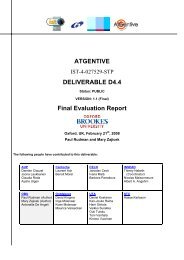pdf 820Kb - INSEAD CALT
pdf 820Kb - INSEAD CALT
pdf 820Kb - INSEAD CALT
You also want an ePaper? Increase the reach of your titles
YUMPU automatically turns print PDFs into web optimized ePapers that Google loves.
2.4 Defining the evaluation process<br />
Evaluation report of the use of Onto-Logging<br />
platform in the user site<br />
Deliverable ID: D8b<br />
Page : 16 of 110<br />
Version: 1.0<br />
Date: 27 january 2004<br />
Status: Final<br />
Confid.: Public<br />
For the different reasons we have already mentioned (cost, time, availability to find<br />
participants, etc.), evaluating everything is not possible, and to some certain extend it is not<br />
really desirable (lack of focus, introduction of rigidity, etc.).<br />
An evaluation process aiming at delimiting the research and conducting it realistically can be<br />
used.<br />
The different stages of this research process in social sciences are the following:<br />
• Stage 1: The definition of a research question. This involves contributing to<br />
building a body of knowledge and developing theory.<br />
• Stage 2: The development of an instrument. Having defined the research question,<br />
the research investigator needs to develop measurement instruments to capture the<br />
data for future analysis and to select the context (the site, the users, etc.) in which the<br />
measurement will take place.<br />
• Stage 3: The data gathering. This stage is related to the execution of the chosen<br />
instruments in the selected context in order to collect the data. This stage may include<br />
the execution of some preliminary actions, such as for instance trust building in the<br />
case that the data has to be collected from people.<br />
• Stage 4: The analysis of the data. This stage consists in the analysis of the data in<br />
the perspective of the research questions that have been previously identified, and the<br />
determination of the learning of the research.<br />
• Stage 5: The dissemination. This stage consists in the selection and the<br />
dissemination of the most important (originality, impact) research finding generated<br />
by this research.<br />
These different stages can be slightly relaxed in the Case Study Research method (Eisenhardt<br />
1998; Yin 1994; Meredith 1998), a method favoured for conducting research in a field of<br />
research that is still largely unexplored, and which characterised by a paucity of theories, and<br />
the complexity and lack of well supported definitions and metrics (Stuart et al., 2002). For<br />
example, Eisenhardt (1989), while acknowledging the role of good research questions and<br />
theoretical constructs, argues that propositions can be developed (and tested) during data<br />
collection, rather than prior to it. Because the aim is to obtain a rich understanding of the<br />
cases in all their complexity, insights gained during data collection can be used to inform the<br />
theory.<br />
2.4.1 The definition of the research questions<br />
An initial definition of the research question should be made in order not to become<br />
overwhelmed by the volume of the data. A priori specification of constructs can also help to<br />
shape the initial design of theory-building research, although this type of specification is not
















